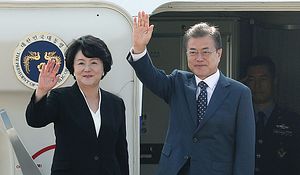Over the weekend, after a long week at the United Nations, South Korean President Moon Jae-in did something unusual for many South Koreans with busy work schedules — he took a vacation.
According to posts from the official Blue House Twitter account on September 30, after returning from New York, Moon spent the weekend hiking in his hometown of Yangsan and enjoying some time off. Moon has taken several breaks since entering office, including a couple of sick days this June, which were also publicized on the Blue House’s social media.
Moon is not the first South Korean president to take vacations — his predecessor, Park Geun-hye, was criticized for taking time off during crises like the 2015 MERS outbreak and the 2014 Sewol Ferry disaster. But Moon does seem to be doing more to publicize his time off, in part because of his focus on improving South Korea’s work-life balance. During his presidential campaign, Moon proposed increasing the mandatory amount of paid vacation days that Koreans receive and creating incentives for Koreans to actually take the vacation they are offered. Shortly after taking office, he pledged to take all 21 of his paid vacation days.
In recent years, South Korea has become famous for its long work weeks, with up to 68 (official) working hours allowed per week. At the same time, few Koreans were taking their allowed breaks — according to a 2017 survey, 23.9 percent of respondents didn’t take any vacation at all the previous year, and the average amount of used vacation time was just 5.9 days.
Moon has already started tackling the first problem, introducing a shortened work week of just 52 hours. In response, companies started automatically shutting computers off in the evening — although that hasn’t precluded some workers from just moving to a nearby cafe with their laptop. Last autumn, the government also declared several extra public holidays to extend the annual Chuseok break to 10 full days — but some reports showed hagwon (cram schools) offering special classes during the long break so students could do some extra cramming ahead of the college entrance exam in November.
Critics of the work week plan have also pointed to lower take-home pay for workers, especially low-wage hourly workers, and a massive financial burden for companies that may have to hire more workers to make up for productivity loss. Because of backlash, the Moon government reluctantly agreed to a slow rollout of the new rules over six months, particularly for small companies with under 300 employees.
Even Moon himself may be having a hard time perfectly living up to his vacation-related pledges. Despite pledging to fully relax during his summer break last year, he ended up taking a meeting with a visiting defense minister, and spent time touring the PyeongChang Olympic facilities ahead of the games. He also received harsh criticism for delaying a call with U.S. President Donald Trump during the vacation period and failing to attend a National Security Council meeting related to a North Korean missile launch at the time.
Amid all this discussion of work hours and vacation time, a new term has entered into the Korean lexicon: wo la bal, 워라밸, an abbreviation formed from the English term “work-life balance.” So while the changes may not be taking hold overnight, and even President Moon is running into roadblocks in his vacation schedule, the conversation in South Korea about a healthier attitude toward work will hopefully continue.
Jenna Gibson is a doctoral candidate in political science at the University of Chicago and a Korea blogger for The Diplomat. You can find her on Twitter at @jennargibson.

































